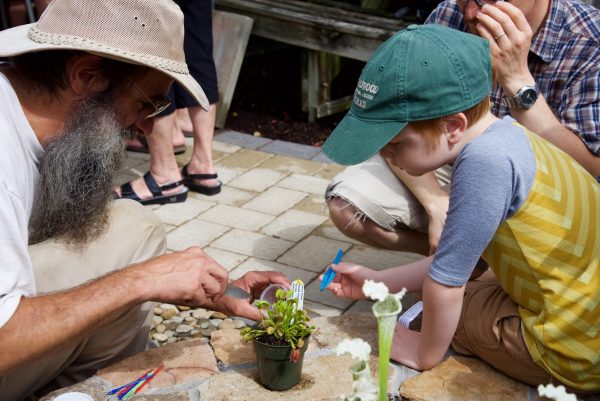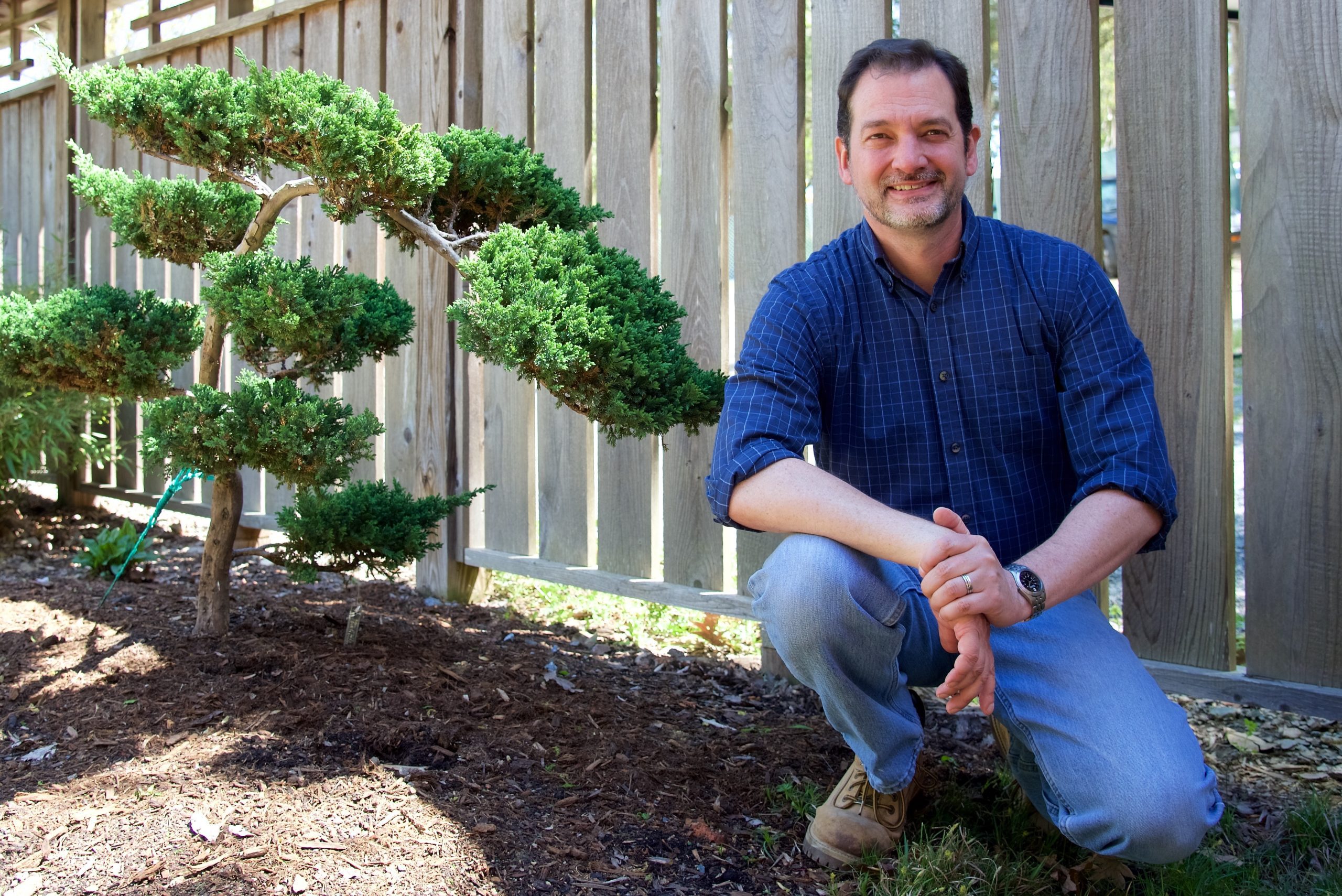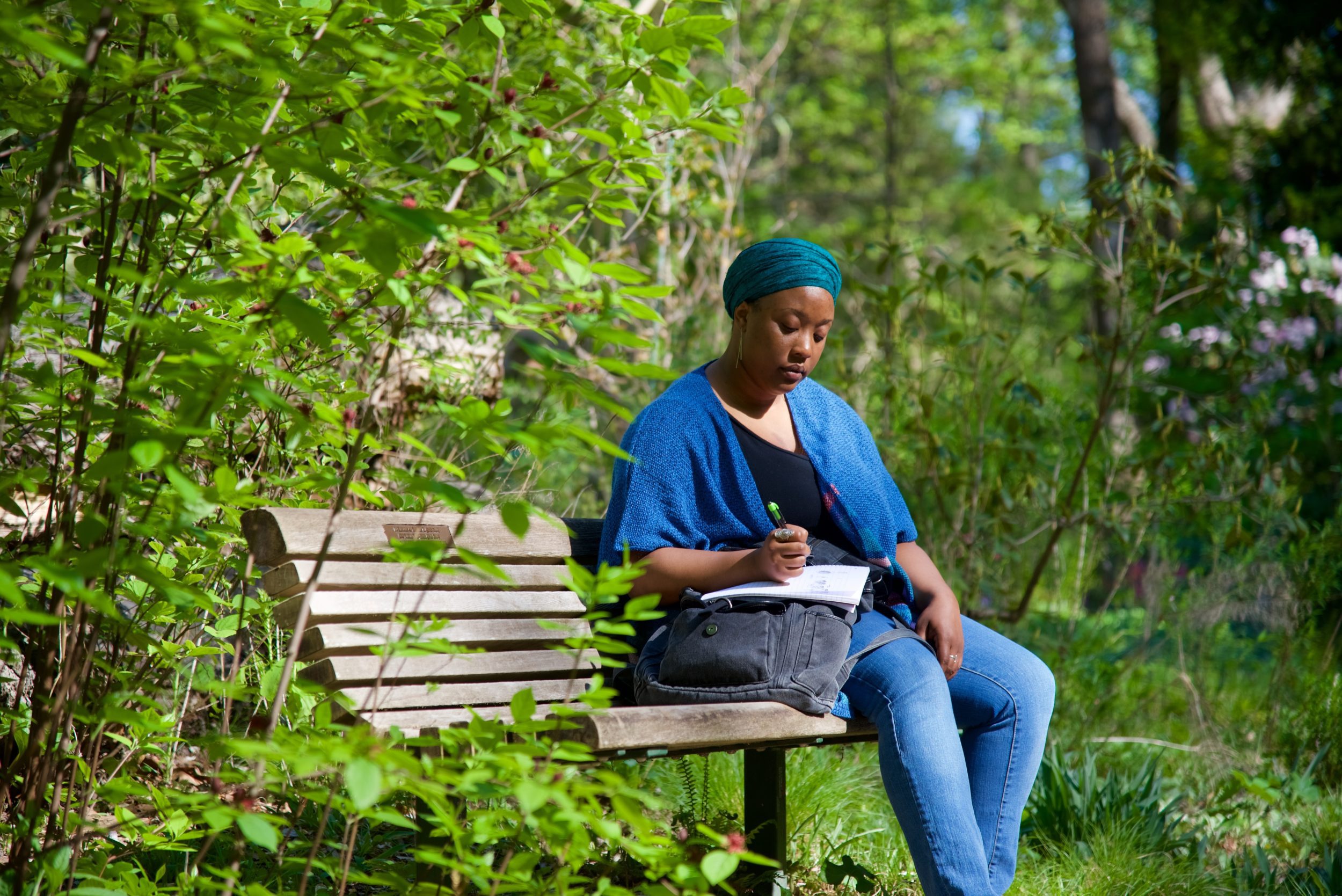Passions Take Root In UNC Charlotte Botanical Gardens

On Oct. 8, 2016, what would have been Spencer Bise’s 21st birthday, his friends and family came to the UNC Charlotte Botanical Gardens to celebrate his too-short life. Attendees gathered under the scarlet leaves of the titi tree dedicated in his honor to offer their remembrances and condolences.
“The dedication ceremony was very helpful to us emotionally,” recalled organizer and Botanical Gardens volunteer Sydney Hillman (’18). “We were very appreciative to be able to honor him in this way.”
Since 1966, the UNC Charlotte Botanical Gardens has served as an outdoor oasis and vibrant classroom for the campus and broader Charlotte community. The Botanical Gardens are open to the public and offer 6,000 plant species over its 10 acres. Hillman’s connection demonstrates the gardens’ significance to the campus and its students.
When she arrived at UNC Charlotte as a freshman, the education major with a love for all things green was immediately drawn to the gardens. It soon became her go-to place to relax, meditate and literally smell the roses. After the tragic loss of her good friend and fellow 49er in October 2015, the gardens also became her place of solace.
A Verdant Gem
“The (McMillan) Greenhouse supported me 100 percent during that time,” said Hillman, referring to one of the gardens’ popular sites. She got the idea for the memorial when Jeff Gillman, director of the gardens, asked how he could help. Dedicating a tree in Spencer’s honor seemed like the perfect way to demonstrate her love for her friend and the gardens.
Hillman is joined by others in her appreciation of the unique attributes of this verdant gem. The UNC Charlotte Botanical Gardens has carved out a niche as a center of botany and horticulture the greater Charlotte metro region; actually, the Botanical Gardens attracts international visitors, but its reputation probably is more accurately described as regional. Certainly people visit regularly from Rock Hill, Statesville, Hickory, Salisbury and other nearby locations. “Our collection of native carnivorous plants includes everything from Venus flytraps to pitcher plants and sundews,” Gillman said. “Perhaps our most interesting collections are our rhododendrons and azaleas. We have thousands of these in the Van Landingham Glen, and they put on an amazing show when they bloom in the spring. The gardens were actually started by the local rhododendron society, so this is our oldest collection.”
“Our collection of native carnivorous plants includes everything from Venus flytraps to pitcher plants and sundews,” Gillman said. “Perhaps our most interesting collections are our rhododendrons and azaleas. We have thousands of these in the Van Landingham Glen, and they put on an amazing show when they bloom in the spring. The gardens were actually started by the local rhododendron society, so this is our oldest collection.”
About 40,000 people visit the Botanical Gardens each year, many to seek out the site’s more than 90 secluded spots. Students study on benches, have lunch at a picnic table or nap in a hammock. Off-campus visitors come to learn, meditate or walk their dogs on paths through the pet-friendly gardens.
Bucolic Classroom
Quite often, the bucolic setting serves as an outdoor lecture hall for classes. Teachers in poetry, graphic design, geography, earth and biological sciences and language and cultural studies have all turned the Botanical Gardens into a classroom to encourage students to embrace nature and gain inspiration from the natural world. Assistant Professor of English Matthew Rowney compares the settings to those found in Wadsworth’s “The Prelude.”
Assistant Professor of English Matthew Rowney compares the settings to those found in Wadsworth’s “The Prelude.”
To keep the gardens in pristine shape and spread the word about their existence, dedicated volunteers support the site.
“The first time I walked through the gardens was on a cold, drizzly day in March,” said landscape designer Lydia Grupinski. “The gardens were still asleep but I recognized how amazing it was and knew I wanted to be a part of it.”
Grupinski volunteers as a Monday Glory and does everything from weeding, pruning and transplanting to labeling plants and leading tours. Hillman, the student, also guides and instructs visitors. She was the first undergraduate volunteer for the Flower Friday program, where visitors receive a free flower and learn about the plant. Educational opportunities are replete for anyone who wants to gain a deeper understanding of plants and horticulture or simply learn how to grow better vegetables. Throughout the year, the “At Home in the Garden Series” offers a range of stand-alone short workshops, such as mailbox gardens and pressed flower art.
Educational opportunities are replete for anyone who wants to gain a deeper understanding of plants and horticulture or simply learn how to grow better vegetables. Throughout the year, the “At Home in the Garden Series” offers a range of stand-alone short workshops, such as mailbox gardens and pressed flower art.
A 100-credit Certificate in Native Plant Studies is also available. The certificate is one of just a few in the Southeast that provides an intense focus on the cultivation and knowledge of native plants. This initiative has influenced other botanic gardens and universities to offer native plant courses and serves to demonstrate the UNC Charlotte Botanical Gardens’ broader impact.
The Botanical Gardens symposium is becoming a must-attend event for gardeners, plant enthusiasts and those interested in creating broader social change through sustainable practices. On Saturday, Jan. 27, 2018, this year’s symposium will focus on “Urban Roots: Transforming the Urban Landscape.” The symposium will investigate topics ranging from nurturing children’s introduction to nature as a learning environment, to cultivating fungi in an environmentally friendly fashion, to participating in the community gardens movement.
“With our concentration on the urban environment, we hope to attract typical gardeners, millennials and urban activists — people who want to turn a concrete jungle into a greener environment,” said Gillman, the gardens’ director.
Fundraising for Facilities
Expanding public outreach is a priority. “Our plant collections and our staff and faculty expertise are outstanding, yet we could do so much more to meet the needs of our campus and broader community through improvements and expansion of our facilities,” said Nancy Gutierrez, dean of the College of Liberal Arts & Sciences. “Our community could benefit greatly from the construction of a welcome center and new conservatories, to provide more instructional, demonstration and event space.”
The University is in the midst of its fundraising initiative EXPONENTIAL: The Campaign for UNC Charlotte. CLAS and gardens leaders are seeking funding for a 15,000-square-foot visitors center and conservatory to serve as a gateway to this green heart of the campus. The first phase seeks $2.5 million.
CLAS gift officers Judy Lekoski and Ali Dubois are working with Gillman, the gardens director, to raise support for what is envisioned as the largest under-glass conservatory complex between Atlanta and Washington, D.C. The classroom, conservatories and gallery area would substantially increase the Botanical Gardens’ ability to provide more and larger educational and community events.
Why this is important ties to the gardens’ power to relate broadly to the campus and the community, Gutierrez said.
“The foundation of life is built upon the diverse plants that cover the Earth,” she said. “Through our Botanical Gardens, our community gains an appreciation of the symbiotic relationship that exists between people and plants. In this living classroom, we explore the scientific aspects of nature, and also the cultural, artistic and humanistic roles that plants play in our lives.”
Words: Melba Newsome | Images: Lynn Roberson | This article first appeared in the Fall//Winter 2017 issue of the UNC Charlotte magazine.